Ants in the Trail Camera
There’s nothing quite like having a nest of ants fall into your lap while you’re ten feet up on a ladder. The other morning, as I retrieved an SD card from a trail camera mounted higher than usual in a tree, I popped open the plastic latch, and a pile of little ants and their larvae tumbled out. Ants account for 15-25% of earth’s terrestrial biomass, so it should not be surprising that a nest occasionally turns up in a trail camera. How and why do they get in? Once they’re in, how can we get them out? And is there an easy way to keep them out in the first place? Answers to all these and more in this week’s post, “Ants in the Trail Camera.”
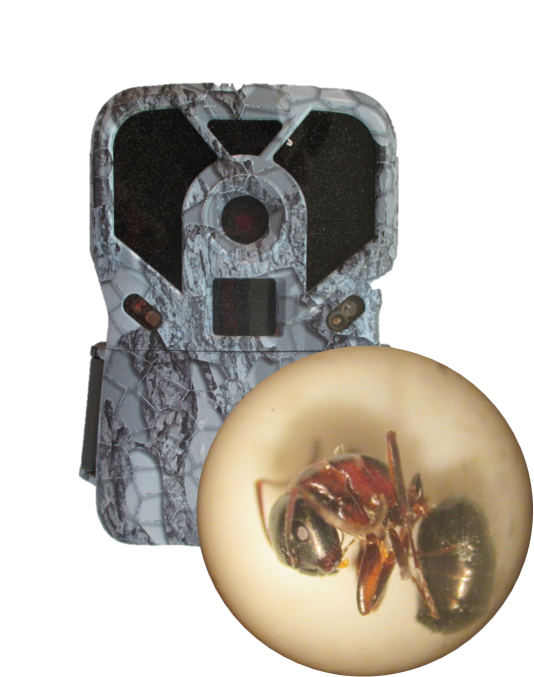
Home Sweet Trail Camera?
I am always impressed by how a colony of ants can so thoroughly explore a complex, and huge (from their perspective) world. If there is a ant resource somewhere in these environments, ants somehow manage to find it. Research conducted on Formica neogagates concludes that: “100 ants in a tree foraging for about 3 h should be able to visit about one quarter of the leaves in a tree.” It’s no wonder some found mine.
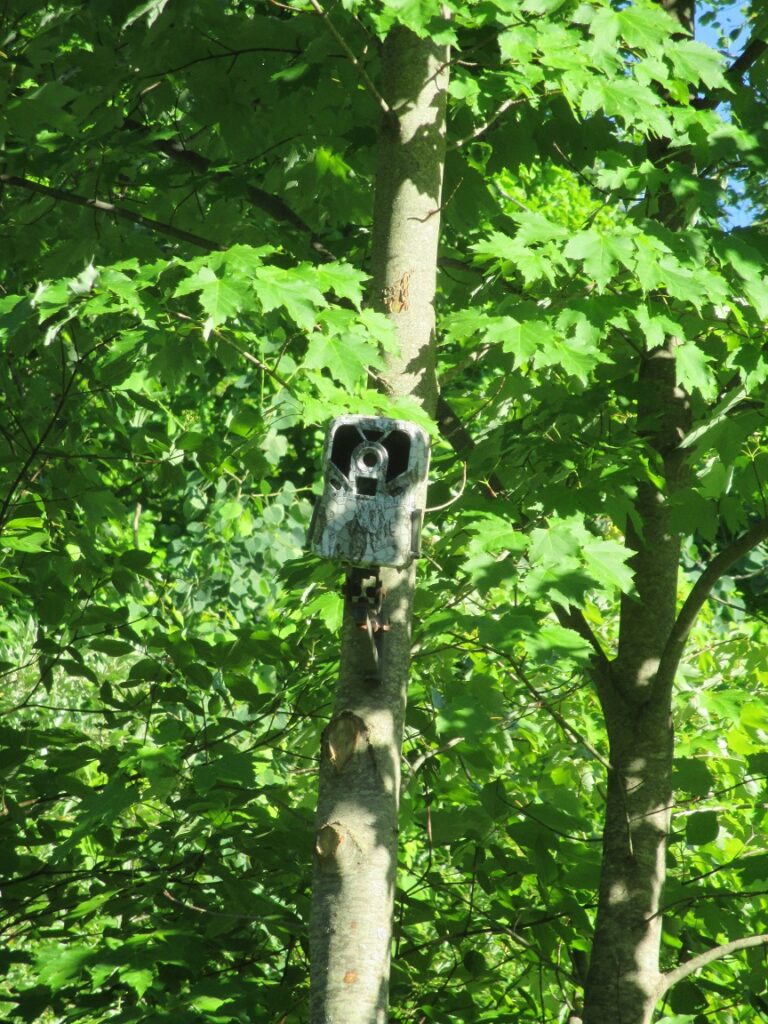
A trail camera provides a valuable resource: a secure and well-protected place to set up their nests. As if by design, they’re just the right size for a small ant colony.
Getting In
Small ants can get through small holes. You might think that the rubber gaskets on trail cameras that keep water out would also keep ants out. However, in addition to the water-tight seals, many trail cameras also have tiny holes in their cases. These are often just the right size for a small ant to squeeze through. These holes serve at least two purposes. They allow:
- The pressure in the camera to equalize with the ambient air pressure as temperature and air pressure changes. If this isn’t done, a partial vacuum can form inside the camera which would, inevitably, pull moisture in. Most “weatherproof” enclosures have such a venting mechanism to solve this problem. There are several ways to make such a vent. A high tech breathable membrane that let’s air in and out, but not water. Or, much less expensively, a small hole in the bottom facing camera housing. Of course, balancing the pressure also allows the pressure sensor in many cameras can work, as well.
- Sound to get to the microphone. The microphone in a trail camera needs to “get outside” of the sealed camera enclosure to hear. The easiest way to to this is through a small hole in the case.
Who are the new neighbors?
I retrieved a few ant corpses with the goal of identifying the type of ant I was dealing with. This proved more challenging than I had thought. Getting a good photograph of a delicate insect, only a few mm long, is hard. Even with a dissecting microscope and electronic view finder, the task is time consuming at best, and frustrating at worst. Below are a few of my better attempts.
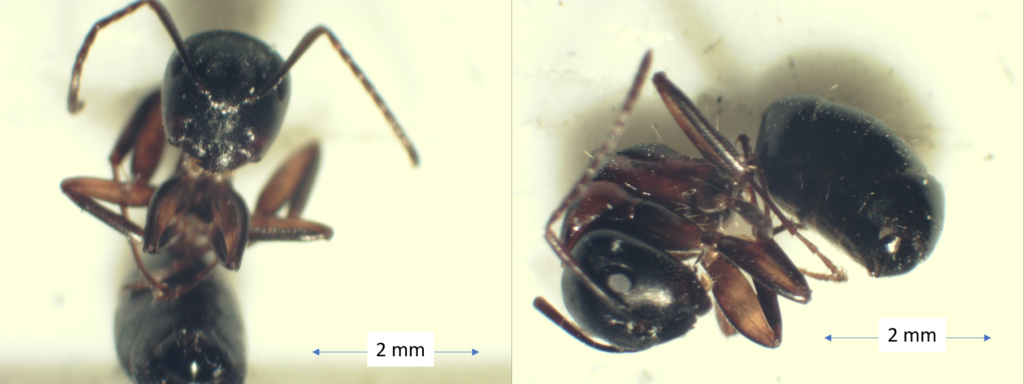
A quick review of antwiki.org for ants found in Massachusetts led to a whole raft of possible suspects. Based on the distinctive shape of the bulbous tail segment (the gaster), I narrowed my search to genus Formica. I then followed the handy Key to New England Formica and emerged with an ID of Formica neorufibarbus. Photos below are for comparison. I cannot help but seek confirmation or a second opinion.
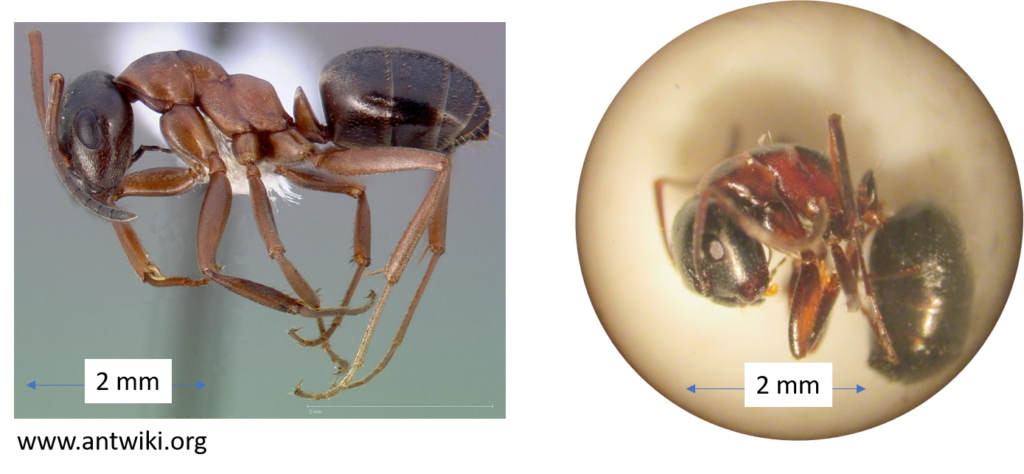
Per Navajo Nature, ” Nests may be made in organic matter, peat moss, dead wood, in soil and under rocks.” Perhaps we can add “inside trail cameras” to this list? Further, “Formica neorufibarbis are generalists, feeding on dead insects, honeydew and whatever other nutritious liquid resources they can find.” This is consistent with them nesting a small maple tree in the middle of a dense, early succession field.
Eviction Notice
We experienced our first camera infestation while retrieving cameras left for a summer season of badger in Wisconsin. When Janet opened the camera to check the SD card, all heck broke loose, with a whole colony of very angry little insects spilling out everywhere. After dropping the camera to the ground like a hot potato, we recovered it long enough to brush out the ants we could see. We retrieved the SD card, and put the whole thing into sealed plastic bag for the trip home. A week later, Janet opened the bag and the camera and found … more ants. I retrieved the camera from the trash bin and placed it in a plastic bag overnight in our freezer. The next morning, I opened up the camera case and cleaned out the dead ant colony.
Research suggests that (see “Tomb Evaders” in reference) some ants are so timid that they will abandon a nest once it is disturbed. I can refute this hypothesis for formica neorufibarbus in trail cameras. On first discovering the infestation, I disturbed the heck out of the nest, including spilling dozens of workers and larvae out of the viewer/settings compartment, and generally shaking the camera around. A few days later, I checked the same camera, and the ants were still in residence.
The same research suggests that some ants will avoid nesting in sites containing evidence of a previous ant colony disaster. Since I knew that this infestation was recent, I tested this hypothesis by replacing the camera on the same tree after a night in the freezer. After 2 days, I can report that ants were trying to move back in. This is not a reliable method for keeping ants out.
Cleaning House
A thorough cleaning will be necessary if the colony is well and deeply established in among the delicate electronics of the camera’s innards and the camera no longer works. Of course, if the camera is still under warranty, you should contact the manufacturer to repair or replace before attempting any repairs yourself, which may void the warranty.
Cleaning is straightforward, although it will require specialized but readily available tools (a set of small screw drivers, or torx drivers, depending on the camera model). Once the case is opened, the remains of the ant colony can be removed with a vacuum cleaner and small brush. Removing frass from the circuit board should be done with great care so as not to damage delicate structures, like the contact pins for the SD card socket. Extreme cases of ant infestation may not be practically repairable.
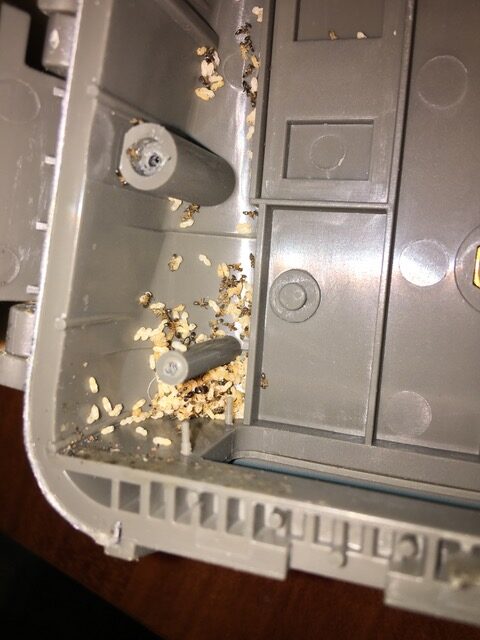
Keep Out!
Most ants nest in the early to mid summer, so cameras out in the world in other times are at low risk for ant invasion. During peak nesting time, I have had good luck with covering any tiny holes in the case with a small piece of micro-porous medical adhesive tape. On most trail camera models, the holes are for the microphone, whose sensitivity is somewhat decreased by the tape. But is is easily removable once the ant season passes.
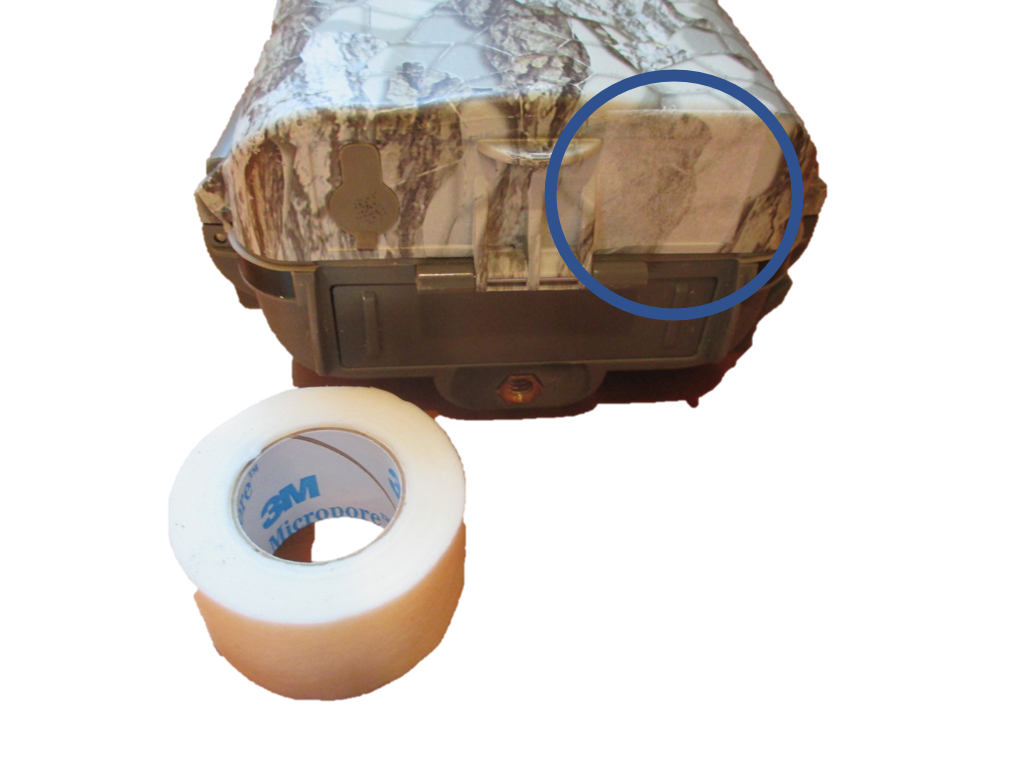
A piece of (less porous) transparent tape may also do the trick, assuming it doesn’t completely seal the hole. Expect even more muffled sound if you use this method to cover microphone holes.
Feedback
Have you had experience with ants in the camera? Have a second opinion on my identification, or insight into the behavior of ant species that might make them prone to colonizing trail cameras? Have you found other solutions? All welcome in comments below.
References
- Antwiki.org
- Franks, Nigel R; Hooper, James; Webb, Catherine; Dornhaus, Anna; “Tomb Evaders: house hunting hygiene in ants,” Biology Letters, May 24, 2005, The Royal Society Publishing.
- Navajo Nature, Formica neorufibarbis Emery
- Wesloh, Ronald M., “Patterns of Foraging of the Forest Ant Formica neogagates Emery (Hymenoptera: Formicidae) on Tree Branches“, Biological Control, January, 2001.

All of my trail cameras are in steel boxes to protect them from bears, raccoons and squirrels; ants and spiders frequently take up residence in the steel boxes. I spray the inside of the steel boxes with one of the Raid products or the permethrin that I use on my field pants. Both work well for keeping both ants and spiders out, but the permethrin lasts longer. I’ve also sealed openings in the cameras themselves with Goop since I seldom care about sound in the videos and don’t consider pressure an issue in a small space like a trail camera.
You’re right about all sorts of things taking up residence in the lock boxes. We generally knock these out with sticks or gloves. In the northeast, this has worked pretty well. There have been times, like the gypsy moth caterpillar outbreak we had in central MA a year or so back, in which a camera box was filled with all sorts of rotting caterpillar corpses (yuck) that we considered the poison route. Then there was the black widow spider we discovered hiding in a camera we retrieved from out west. Best to pay attention during the whole process! Thanks for commenting.
Just don’t use DEET as it could melt the plastic.
I have tried all these and still have issues with Ants, Earwigs & Gypsy Moths that take up residence in my Security Boxes. I have also taped offmost of the Holes in the Gae Camera. The Powders use have been Ant Dust, Sevin (5) Dust, Diatomaceous Earth, Ant, Flea & Tick Granules & Permethrin. Alone and a mix and yet I still have Ants, Spiders, Earwigs & Gypsy Moth Caterpillars move in. I have put these also on Cotton Balls which are to exterminator these when coming in contact yet I see Ant’s, Spiders & Earwigs crawling through any / all of these inside the Security Box! I recently put in “Bay Leaves” also in the boxes and after a week There is still Ants and Earwigs crawling around? I have also tried spraying Ant / Roach Killer on Cotton Balls being careful not to get any on the Camera as it melts the plastic but still have insects? For me I think the Metal Security Boxes are part of the Attractant, as they get warm in the sun and slow cool down so maybe the Ant’s like the warmth and stay! Add in that there is so many Holes in the security box they have many ways to get in. From the Cable Lock Holes as there are 2 to 3 sets along the side, then the corners at the top are not sealed off the holes are large enough to let Ants in. Add on the Power Port Holes for External Power Sources and difficult to close off all these especially the cable lock holes as Ants have easy access. I have taped off most holes I am not using but I cable lock all my Cams even the Mic Hole as I do video but sound is not as importan as to losing a Camera. This Year I have not checked all my Game Cameras and lost 2 so far to Ant’s. Did The Freezer Tip but those 2 cams would not turn back on. The 3rd is current in the Freezer but it is not looking good! Icontinue to readarticles saying ants do not like this or than including Bay Leaves but after a week I had both Ants and Earwigs crawling across these and the Insect Powder Killers that do not seem to work! I run 12 cameras and starting to take a couple down and bring them Home totape pff each and every hole I am not needing to Use! Bit I have psray above and below with some kind of Ant Killer Spray but it seems to wash off once it rains? So Still looking for something. As my Cameras are out 24 / 7. Might move the Cameras to a T-Post type Mount instead of strapped to a Tree. But that means modifying the security box as few are predrilled to use the 1/4 -20 Insert in the Camera and it is not simple to to align the 1/4- 20 Insert through the bottom of the box. And hope the Threaded 1/4 – 20 is long enough to reach andsecure the camera and box to!Might be that the Trees are easy to climb and have insects on them maybe a T-Post being steel might not attract them as much. Not see many insects on the T-Post enclosing my fruit and nut trees I have planted. But after losing a few camera It is getting costly using Cams add in the cost of Lithium Batteries has tripled this year. Will have to also start Checking Cameras more to try and catch the the Insect soon and not moved in to the inside of the Camera including the SD Clot and The Battery Slot.
Wow — sorry to hear that you’re having so much trouble with insects. But you are right about the security boxes — they are practically impossible to make insect proof. I think I would hesitate to use any insecticides on security boxes placed in the field for fear of inadvertently poisoning animals sniffing, rubbing, or licking the camera. Still, we don’t have the same degree of problem you do. Occasionally, we get insects making their homes in the metal security boxes, but it’s mostly spiders and their eggs and prey remains, which we remove with a stick or a gloved finger. Certainly, a lot of insects in the security box will increase the odds that some find their way into the camera. We’ve had good experience with Browning ReconForce and SpecOps models keeping insects out, even when they get into the security box.
For your damaged cameras, have you tried opening them up after they’re out of the freezer? Depending on the extent of the infestation, you may be able to use pressurized air to remove the carcasses. A cotton swap with a little isopropyl alcohol may be enough removed frass from the circuit boards. They may yet work after being cleaned.
Can you tell how the insects are getting into the cameras themselves?